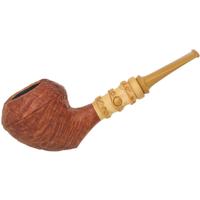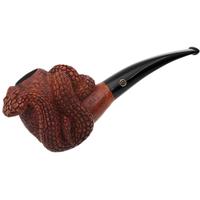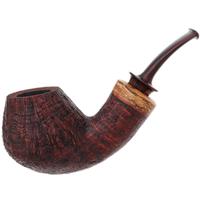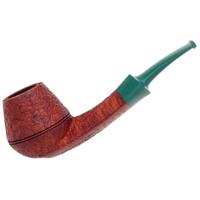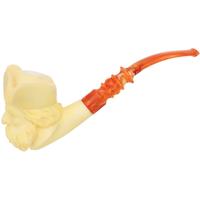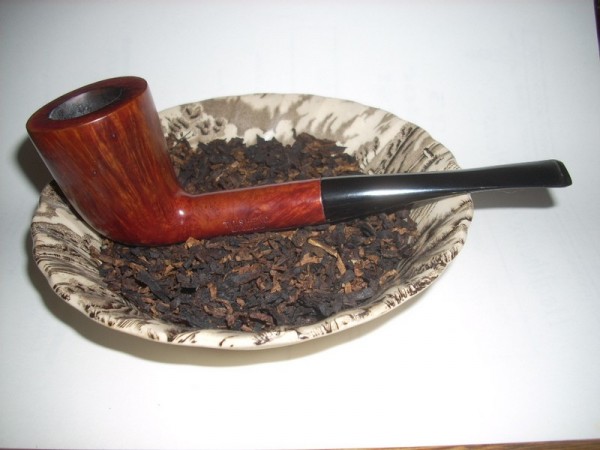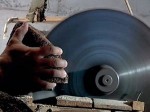James Upshall Pipes - A Discussion
- Thread starter tarheel1
- Start date
I wasn't thinking that you were - it seems that I imagined that people in the pipe manufacturing business/pipe-makers all know "the golden rule" and that is to always strive to improve quality otherwise it will kill their business. I can also imagine the disappointment that Barry may have experienced when he was asked to stamp/engrave seconds with James Upshall. Of course pipe collectors know which seconds come from which factory/workshop but it is about preserving/improving the quality rather than the easy option of 'going cheap'. I am not judging anything here, it is merely an observation. Thanks Robski for the education.
Otto Braun my briar supplier who, incidentally supplied Alfred Dunhill with his briar pre-world war 11 and after and also Charatan, always said to me "Ken, the ABC of this business is to keep your quality as high as you can otherwise it will kill the business. That, coupled with my father's saying "quality, quality and more quality (with a little more quantity) is what is needed.
Hey Ho!
A saying by Nichiren Daishonin (around 1265) "not to advance is to retreat"
Hey Ho!
A saying by Nichiren Daishonin (around 1265) "not to advance is to retreat"
Kenbarnes said...
Otto held an equity position in many saw mills. He was his own best salesman, and sold for mills that he didn't own, visiting pipe makers all over the world. Otto knew more about briar than anyone I ever knew. I saw him many times at Ken's factory and at the RTDA.
Otto, directly or indirectly supplied, in addition to the companies that Ken mentioned, many other English, Danish, Italian, American makers. He supplied the carres (small blocks) for Falcon and I believe Barling's plateaux after the Algerian Civil War.
A strong relationship with Otto (as Ken had) was the best policy for a pipe maker. Ken never argued price with Otto. If you squeezed him on price your quality suffered. Going to a new saw mill was a bad idea unless you checked the ownership and even then, Otto's influence could affect what you received.
Otto would ask Ken about the quality of a shipment and if deficient, he would correct the situation. He liked steady, tranquil business and he was liberal in extending credit terms if he liked you. He complained about the makers who, in his thinking, cheapened their products by purchasing second rate plateaux. Really interesting man who knew more stories and secrets in the industry than could be imagined.
RIP Otto.
Otto Braun is a name that collectors should know. He was a slight, balding, bespectacled, German man who looked more like an accountant than the world's briar czar but that was what he was.Otto Braun my briar supplier who, incidentally supplied Alfred Dunhill with his briar pre-world war 11 and after and also Charatan
Otto held an equity position in many saw mills. He was his own best salesman, and sold for mills that he didn't own, visiting pipe makers all over the world. Otto knew more about briar than anyone I ever knew. I saw him many times at Ken's factory and at the RTDA.
Otto, directly or indirectly supplied, in addition to the companies that Ken mentioned, many other English, Danish, Italian, American makers. He supplied the carres (small blocks) for Falcon and I believe Barling's plateaux after the Algerian Civil War.
A strong relationship with Otto (as Ken had) was the best policy for a pipe maker. Ken never argued price with Otto. If you squeezed him on price your quality suffered. Going to a new saw mill was a bad idea unless you checked the ownership and even then, Otto's influence could affect what you received.
Otto would ask Ken about the quality of a shipment and if deficient, he would correct the situation. He liked steady, tranquil business and he was liberal in extending credit terms if he liked you. He complained about the makers who, in his thinking, cheapened their products by purchasing second rate plateaux. Really interesting man who knew more stories and secrets in the industry than could be imagined.
RIP Otto.
I dealt exclusively with Otto when I was running James Upshall, except on one occasion when I purchased a few dozen blocks of plateau from Stan Haney (after he stopped making pipes for Ashby Hall)
We had many talks about his adventures before the war and after. Firstly, when he was taken prisoner by the Americans, he was one of Rommel's interpreters (as he spoke so many languages) in Morocco and, on being taken prisoner, the Americans asked him what his trade was to which he replied 'smoking pipes'. Because of this, they sent him to the Winston Salem factory and he told me that he was asked (told!) to paint/limewash the inside of it. He told me it was so big i.e. miles of walls to paint! One of the most memorable stories he told me was towards the final years of the war he was living in Switzerland with his wife. All the briar sawmills were at a sandstill and he had no money. One of his customers before the war was Alfred Dunhill and Otto knew that Dunhills had run out of briar at this time and the demand for pipes was huge (mostly from the troops). Otto told me that he and his wife WALKED from Switzerland to London and he went to see Alfred and explained that he could supply him with briar but he had no money to open up the sawmills. At this point Alfred gave him (if I remember correctly) £25,000 as an advance to start up operations again. This was a huge amount of money in 1944!
We had many talks about his adventures before the war and after. Firstly, when he was taken prisoner by the Americans, he was one of Rommel's interpreters (as he spoke so many languages) in Morocco and, on being taken prisoner, the Americans asked him what his trade was to which he replied 'smoking pipes'. Because of this, they sent him to the Winston Salem factory and he told me that he was asked (told!) to paint/limewash the inside of it. He told me it was so big i.e. miles of walls to paint! One of the most memorable stories he told me was towards the final years of the war he was living in Switzerland with his wife. All the briar sawmills were at a sandstill and he had no money. One of his customers before the war was Alfred Dunhill and Otto knew that Dunhills had run out of briar at this time and the demand for pipes was huge (mostly from the troops). Otto told me that he and his wife WALKED from Switzerland to London and he went to see Alfred and explained that he could supply him with briar but he had no money to open up the sawmills. At this point Alfred gave him (if I remember correctly) £25,000 as an advance to start up operations again. This was a huge amount of money in 1944!
@GeorgeD said...

Marble Arch sold several high-end Italian brands along with Upshall that gave us some cross market insight. The collectors of the 1980s put a premium on size (not all) and we challenged our pipe makers to continually refine their shapes as balanced smoking instruments. The large Charatan pipes appealed to showpiece collectors but that was a smaller, more niche market.
Cost/benefit analysis wasn't in the Upshall lexicon, nor mine...I wondered if some sort of cost/benefit analysis was ever performed on the assumption that the smoking public preferred a flawless outer surface on an over-sized, sometimes awkward pipe enough to offset the higher briar drop rate of making smaller and more elegant ones. Because I knew any number of smokers who avoided Charatans because of their size. People who said they would have bought them otherwise.
This thread is obviously my chance to get that answer. Ken? :?:
Marble Arch sold several high-end Italian brands along with Upshall that gave us some cross market insight. The collectors of the 1980s put a premium on size (not all) and we challenged our pipe makers to continually refine their shapes as balanced smoking instruments. The large Charatan pipes appealed to showpiece collectors but that was a smaller, more niche market.
The challenges I faced when cutting the plateau blocks was... as I cut into the briar to present it as clean and to find the grain (and cut away the nucleus of the root)i.e what looks like branch wood but is at the core and to 'tilt it when required so the grain became more perpendicular, as the block reduced in size,invariably the grain became tighter and more prominent. Sometimes, when Barry turned the tobacco hole (scooped it out), the grain on the inside of the bowl was tighter and more beautiful than the outside. Pete mentioned something Barry had told him, which I did not know about until four weeks ago, about the difference between Barry as a cutter and my cutting 'style'. Barry's words were "Ken cuts what he sees, I cut what I know." I think Barry was referring to the art of cutting that he had learnt was keep it as large as possible (cut the block to position the grain so that, when it is turned on a lathe, the grain will 'reveal' itself. I agree with this from a general perspective of 'big is beautiful' or easy to sell (in the Charatan US market) and let the turner reveal the grain rather than the cutter. I cut what I saw and when I saw the grain intensify as I cut it, that's what I wanted! I wanted the grain to intensify! However, the drawback is that sometimes when this type of cut-block is turned the grain starts to disappear as the shape is formed. Barry was the better cutter/turner because he could either cut in order to reveal the grain when HE turned it or visa-versa. Did any of that make any sense to anyone else?
Sorcery I say! Very interesting and thank you for your insights, a real eye opener. :clap:Did any of that make any sense to anyone else?
Howdy Ken,
Your description takes me back.
There are many things that I never told you, mainly because I was too busy breaking your balls and criticizing production. Your Cutting wasn’t my first nor only rodeo. I discussed your Cutting with the Italian makers regularly, with Otto and English pipe makers too. They thought your methods to be mad (not Otto) but they admired your skill. You know how Otto felt because of the quality of wood that he supplied.
Barry’s skills were art and his Turning was infinitely superior to yours, so I was always grateful that you stuck to Cutting! Barry Turned most (all) of your Cut blocks and if he preferred his own (blocks), he never said. You perfectly describe bringing the tightest grain into the core, (where the tobacco chamber will be scooped). From a smoking perspective this is optimal and it’s also the best way to have balanced grain all around the bowl (larger circumference) even if not as tight as the center. Is there a better way to Cut?
A proper discussion of Cutting must include briar, a topic unto itself, but I’ll summarize a few points. Grain is more than just a cosmetic device, (mentioned before), it indicates position within the burl, approximate age and that as much resin and extractives were removed, as possible, at the sawmill. Grain is xylem, the vascular system of the burl. Wash, pulp or branchwood are portions of the burl, usually nearer to the stem (stalk), that have less age and vascular ability to be cleansed of resins. The Cutter must remove unwanted portions of wood, eliminate dangerous flaws (like horseshoes) and design a shape that accentuates grain. Xylem growth fans outward so grain is most easily expressed on shapes that mimic this pattern, like Dublins or Volcanos and their variants. Making a handmade, straight grain billiard takes a higher level of expertise.
Your description takes me back.
There are many things that I never told you, mainly because I was too busy breaking your balls and criticizing production. Your Cutting wasn’t my first nor only rodeo. I discussed your Cutting with the Italian makers regularly, with Otto and English pipe makers too. They thought your methods to be mad (not Otto) but they admired your skill. You know how Otto felt because of the quality of wood that he supplied.
Barry’s skills were art and his Turning was infinitely superior to yours, so I was always grateful that you stuck to Cutting! Barry Turned most (all) of your Cut blocks and if he preferred his own (blocks), he never said. You perfectly describe bringing the tightest grain into the core, (where the tobacco chamber will be scooped). From a smoking perspective this is optimal and it’s also the best way to have balanced grain all around the bowl (larger circumference) even if not as tight as the center. Is there a better way to Cut?
Every Cutters aspiration, yet you describe it like you were making a spot of tea. You don't know how others Cut but I do.‘tilt it, when required so the grain became more perpendicular’
A proper discussion of Cutting must include briar, a topic unto itself, but I’ll summarize a few points. Grain is more than just a cosmetic device, (mentioned before), it indicates position within the burl, approximate age and that as much resin and extractives were removed, as possible, at the sawmill. Grain is xylem, the vascular system of the burl. Wash, pulp or branchwood are portions of the burl, usually nearer to the stem (stalk), that have less age and vascular ability to be cleansed of resins. The Cutter must remove unwanted portions of wood, eliminate dangerous flaws (like horseshoes) and design a shape that accentuates grain. Xylem growth fans outward so grain is most easily expressed on shapes that mimic this pattern, like Dublins or Volcanos and their variants. Making a handmade, straight grain billiard takes a higher level of expertise.
Actually, I have never hand-turned a pipe on a lathe in my life. I did try it once and, after a few minutes, I remember feeling really uncomfortable with this. I think that this was partly due to a memory of a guy at Charatan's (I can't remember his name), who lost an eye when the chisel flew up into it. I did, however, turn bowls on the copy-frazing machines at Charatan for a while (making series models). When I was in Arta, which is a village at the foothills of the Pindou Mountains in Greece and also the name of the sawmill company producing the best briar (by far), I remember watching Costa, who was the most experienced digger, digging up a root for ME to cut on one of their 18" saws. Otto said that I was the only Englishman to have sat in front of this very large exposed saw and cut the wet and slippery burl into a plateau block. Apparently, when Alfred Dunhill visited this same sawmill for the first time, one of the cutters asked him if he would like to have a go. Apparently, he went white and declined the offer. Later, this block was sent to me wrapped specially in a bag of briar and it did became a huge JU pipe, I think it was the biggest James Upshall ever made,although lacking in grain as I recall.I brought it to the RTDA convention in Chicago that year and Pete bought it. I think it was a 'B' grade - it was MASSIVE. I wish I had the photos that Otto had taken of me that day but alas.... Lots of emotions just writing this. I wonder what became of this pipe?
I'm in the restaurant business, and we let 18 year olds handle the meat slicers. But that pictures scares the bejesus out of me!
Jvnshr,
Thanks for posting the better picture. Size of hands, position of thumb and being off the table-bed makes this Ken Cutting. Watch that thumb!
 . My skills at pipe making are the same as Ken's, except that I couldn't Cut anything but myself.
. My skills at pipe making are the same as Ken's, except that I couldn't Cut anything but myself.
Apologies if I listed about the grades below the "P" before. They were:
"R" = Least expensive branded James Upshall (link below to an "R" currently on eBay).
Deeper red, less bright and a bit of a matte finish, the bowls were often (always) carbonized. Same great briar, same craftsmen, but these had cosmetic (not serious) flaws that were hidden with stain. They were culled from the best Tilsheads and it was a way to keep the company solvent as Tilsheads still cost more to make than their raw materials.
James Upshall "R"

"S" = originally a German orange/red finish. German distributor wanted the exclusive so we changed to a bright, deep red, with natural bowl, as the "S". A shipment was received with this grade incorrectly marked as "A".
This (posted earlier in this thread) is an "A" that was supposed to be an "S" (as above)

"A" = Was supposed to be better than the "P" or a large "B" grade with a hand-cut rod vulc stem. Only the prototype was ever made (I bought it on eBay last year). Some "S" came through, marked as "A" (see link above). Years later the "A" (link below) was a dark tan finish priced below the "P" and followed by the "R" that largely replaced the red "S".
This is an example of the later "A" finish (dark tan).

I'm not sure if Ken was still at Upshall when the "A" (dark tan) and "R" were being made. Tilsheads were still over a third of production.
Thanks for posting the better picture. Size of hands, position of thumb and being off the table-bed makes this Ken Cutting. Watch that thumb!
You were the only Cutter I knew who specialized. Not only didn't you Turn, you didn't Shape and the few times that you stained a pipe, Shirley would fix it after you were finishedActually, I have never hand-turned a pipe on a lathe in my life.
Apologies if I listed about the grades below the "P" before. They were:
"R" = Least expensive branded James Upshall (link below to an "R" currently on eBay).
Deeper red, less bright and a bit of a matte finish, the bowls were often (always) carbonized. Same great briar, same craftsmen, but these had cosmetic (not serious) flaws that were hidden with stain. They were culled from the best Tilsheads and it was a way to keep the company solvent as Tilsheads still cost more to make than their raw materials.
James Upshall "R"

"S" = originally a German orange/red finish. German distributor wanted the exclusive so we changed to a bright, deep red, with natural bowl, as the "S". A shipment was received with this grade incorrectly marked as "A".
This (posted earlier in this thread) is an "A" that was supposed to be an "S" (as above)
"A" = Was supposed to be better than the "P" or a large "B" grade with a hand-cut rod vulc stem. Only the prototype was ever made (I bought it on eBay last year). Some "S" came through, marked as "A" (see link above). Years later the "A" (link below) was a dark tan finish priced below the "P" and followed by the "R" that largely replaced the red "S".
This is an example of the later "A" finish (dark tan).

I'm not sure if Ken was still at Upshall when the "A" (dark tan) and "R" were being made. Tilsheads were still over a third of production.
I trained at the Charatan factory for one year as a sander (shaping the bowls after they were 'trimmed' on the saw using a coarse sand paper 60 grit, a 120 grit (medium) and a 400 grit (fine). This is where a necessary skill takes place. I sat next to and was trained by Joan Nicholson who sanded all the freehands coming out of Charatans. She was truly the finest paperer that I have come across. I am sure that Barry, Dan and Stan would all agree with this statement. Stan however did, on occasions sit at the sanding-wheel in front of me 'to paper his own'. I think that he thought he may be a superior paperer than Joan,or he may have been a little over protective about the 'Jewels' he had just turned or he was just helping out as Joan may have had to much work 'coming through'. Sanding is the make or break stage of the pipe-making business and my father knew that, so he wanted me to get trained up with Joan as my mentor. This process is normally carried out by women as they seem to be more patient. Before sandpaper was invented, Frederick Charatan used shark skin. An old shark's skin for the coarse grit and younger for finer grits (i.e. the younger the shark the finer the grit). For the record, that was my speciality before I started cutting. Barry meanwhile was an amazing sand-paperer, so patient, so skilled and could transform a piece of **** into something amazing.
I don't believe that I have ever seen an R grade before.
Do you or Ken know what percentage of each grade might be (from the total made on an annual basis)
From my observations, it seems that the grades that pop up the most often on Ebay, in descending order are below (purely anecdotal).
P (most)
G
B
S (Least)
Do you or Ken know what percentage of each grade might be (from the total made on an annual basis)
From my observations, it seems that the grades that pop up the most often on Ebay, in descending order are below (purely anecdotal).
P (most)
G
B
S (Least)



